Description
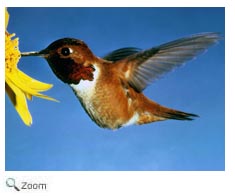 The rufous hummingbird is is 3-4 inches in length and has a wingspan of 4 inches. It has a long, thin bill and tiny feet. The male has a red throat and reddish-brown sides, head, face, and rump.
It has a white chest and a creamy white belly. The male's tail
is reddish-orange and has black tips.
The female has a greenish-bronze back, a white throat and chest, and reddish-brown sides. The female's tail is orange, black and green and has a white tip. The rufous hummingbird is is 3-4 inches in length and has a wingspan of 4 inches. It has a long, thin bill and tiny feet. The male has a red throat and reddish-brown sides, head, face, and rump.
It has a white chest and a creamy white belly. The male's tail
is reddish-orange and has black tips.
The female has a greenish-bronze back, a white throat and chest, and reddish-brown sides. The female's tail is orange, black and green and has a white tip.
Range
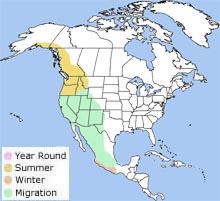 The rufous hummingbird is found in the northwestern United States and Canada. It breeds from southern Alaska south to northern California and east to Montana and Idaho. It winters in Mexico. It is sometimes a vagrant or stray visitor in eastern states. The rufous hummingbird is found in the northwestern United States and Canada. It breeds from southern Alaska south to northern California and east to Montana and Idaho. It winters in Mexico. It is sometimes a vagrant or stray visitor in eastern states.
Habitat
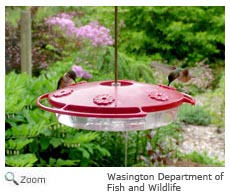 The rufous hummingbird is found in forested and brushy areas, and forest edges. It winters in oak forests, mountain meadows, and in brush and scrubland areas. It can also be found in gardens. The rufous hummingbird is found in forested and brushy areas, and forest edges. It winters in oak forests, mountain meadows, and in brush and scrubland areas. It can also be found in gardens. |
|
Diet
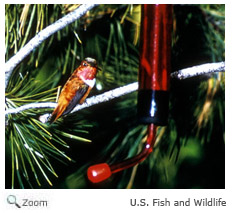 The rufous hummingbird hovers over a flower and uses its long tongue to collect nectar. It also eats tree sap and insects like
wasps, flies, ants and beetles.
It catches insects in the air or snatches them off leaves or branches. The rufous hummingbird hovers over a flower and uses its long tongue to collect nectar. It also eats tree sap and insects like
wasps, flies, ants and beetles.
It catches insects in the air or snatches them off leaves or branches.
Life Cycle
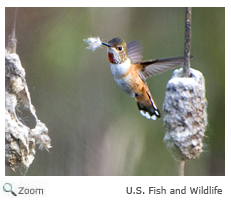 The male rufous hummingbird mates with more than one female. The female goes to the male's territory. The male courts the female by flying in the air and then diving towards her before pulling up just before he reaches her. His wings beat at a rate of 200 beats per second during this display and make a humming sound! The female builds a nest in a shrub, bush, or tree. The nest is made of plant matter and covered with lichen and moss held together with spider webs. The female lay 2 eggs and incubates them for 12-14 days. The female feeds and cares for the chicks. The chicks fledge when they are 7-10 days old. The male rufous hummingbird mates with more than one female. The female goes to the male's territory. The male courts the female by flying in the air and then diving towards her before pulling up just before he reaches her. His wings beat at a rate of 200 beats per second during this display and make a humming sound! The female builds a nest in a shrub, bush, or tree. The nest is made of plant matter and covered with lichen and moss held together with spider webs. The female lay 2 eggs and incubates them for 12-14 days. The female feeds and cares for the chicks. The chicks fledge when they are 7-10 days old.
Behavior
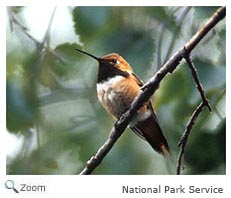 The rufous hummingbird is a solitary bird. The male is very territorial and will protect his mating territory by fighting off other males in mid-air! The rufous hummingbird is a solitary bird. The male is very territorial and will protect his mating territory by fighting off other males in mid-air!
|